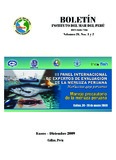Por favor, use este identificador para citar o enlazar este ítem:
https://hdl.handle.net/20.500.12958/1017Registro completo de metadatos
| Campo DC | Valor | Lengua/Idioma |
|---|---|---|
| dc.contributor.author | Tam Málaga, Jorge | |
| dc.contributor.author | Jarre, Astrid | |
| dc.contributor.author | Taylor, Marc | |
| dc.contributor.author | Wosnitza-Mendo, Claudia | |
| dc.contributor.author | Blaskovic' Huayta, Verónica | |
| dc.contributor.author | Purca Cuicapusa, Sara | |
| dc.contributor.author | Vargas López, Nathaly | |
| dc.contributor.author | Díaz Acuña, Erich | |
| dc.contributor.author | Argüelles Torres, Juan | |
| dc.date.accessioned | 2012-11-15T20:29:21Z | |
| dc.date.available | 2012-11-15T20:29:21Z | |
| dc.date.issued | 2009-12 | |
| dc.identifier.citation | IMARPE | es_ES |
| dc.identifier.citation | Bol Inst Mar Perú. 24(1-2) 2009: p. 27-33 | |
| dc.identifier.issn | 0378-7699 | |
| dc.identifier.uri | https://hdl.handle.net/20.500.12958/1017 | |
| dc.description | Boletín IMARPE vol. 24, nº 1-2, 2009. p. 27-33 | es_ES |
| dc.description.abstract | Se plantea la hipótesis de que la merluza requiere un manejo basado en el enfoque ecosistémico para su recuperación. El objetivo es realizar simulaciones con un modelo ecotrófico multiespecífico, con dos estadios de merluza, para entender las interacciones tróficas de la merluza con sus presas, competidores y depredadores. Las simulaciones con factores biológicos y ambientales, sugirieron que la reducción poblacional de la merluza se atribuye más a factores biológicos (relaciones tróficas y presión de pesca) que a factores ambientales. En general, las proyecciones de biomasa del modelo sugirieron que el stock de merluza a bajos niveles poblacionales presenta una limitada resiliencia. | es_ES |
| dc.description.abstract | ABSTRACT: It is hypothesized that hake requieres an ecosystem approach to fishery management for its recovery. The objective is to carry out simulations with a multispecific ecotrophic model, with two stages of hake, to understand the trophic interactions of hake with its preys, predators and competitors. Simulations with biological and environmental factors, suggested that population reduction of hake is attributed more to biological factors (trophic relationships and fishery pressure) than to environmental factors. In general, biomass model projections suggested that low levels of hake stock present a limited resilience. | |
| dc.language.iso | spa | es_ES |
| dc.publisher | Instituto del Mar del Perú | es_ES |
| dc.relation.ispartofseries | Boletín IMARPE vol. 24, nº 1-2, 2009. p. 27-33 | |
| dc.rights | info:eu-repo/semantics/openAccess | |
| dc.rights.uri | https://creativecommons.org/licenses/by/4.0/ | - |
| dc.source | Instituto del Mar del Perú - IMARPE | |
| dc.source.uri | Repositorio Digital IMARPE | |
| dc.subject | Merluza Peruana | es_ES |
| dc.subject | Ecosistema Marino | es_ES |
| dc.title | Modelado de la merluza en su ecosistema con interacciones tróficas y forzantes ambientales | es_ES |
| dc.title.alternative | Ecosistemic modelling of Peruvian hake, trophic interactions and environmetal forcing | es_ES |
| dc.type | info:eu-repo/semantics/article | es_ES |
| Aparece en las colecciones: | Boletín 24(1-2), 2009 | |
Ficheros en este ítem:
| Fichero | Descripción | Tamaño | Formato | |
|---|---|---|---|---|
| BOL 24(1-2)-5.pdf | 2,85 MB | Adobe PDF |  Visualizar/Abrir |
Este ítem está sujeto a una licencia Creative Commons Licencia Creative Commons

